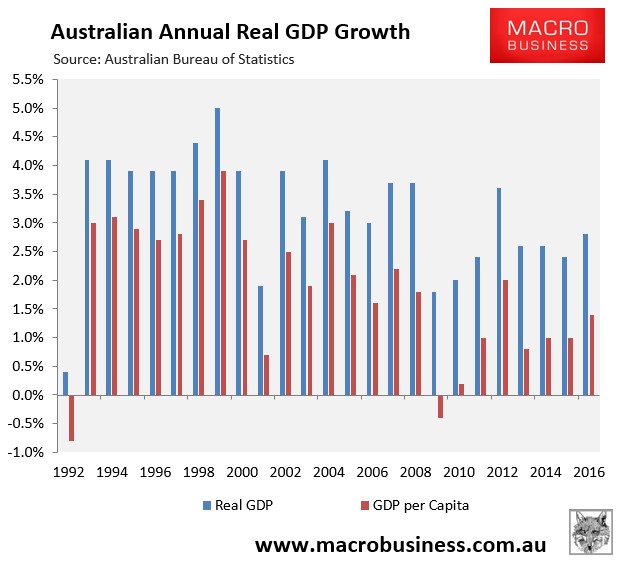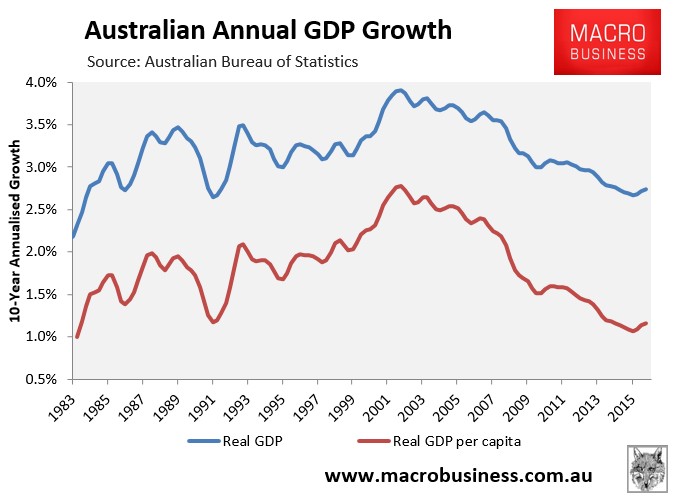Senator Leyonhjelm scored Australians a win by securing a deal with the Turnbull Government to report the Budget numbers in per capita terms. From The Conversation:
The government’s horse trading over legislation with the senate will have a profound effect on the way the government reports economic data.
Part of the government’s agreement with Senator Leyonhjelm to support the reinstatement of the Australian Building and Construction Commission was that many government budget numbers be reported in per capita (i.e. per person) terms.
So rather than reporting economic growth as one monolithic number, the government will take that number and divide it by the total population. Doing so will enable us to better see how much an average Australian has gained or lost.
This change to Budget reporting is actually very important as it will shine a light (albeit indirectly) on the population ponzi run by the federal government. No longer will it be able to focus attention solely on aggregate growth, but will also show how that growth is being divided among Australia’s rapidly growing population.
Indeed, while the federal government often claims credit for Australia’s quarter century of uninterrupted growth, the situation is far less flattering when the economy is considered on a per capita basis, with the economy actually sliding backwards in two of those years (see next chart).

Worse, since immigration was initially ramped-up in the early-2000s, Australia’s per capita GDP growth has plummeted to levels not seen since the early-1980s and early-1990s recessions:

What has been happening in Australia’s is that mass immigration has given the economy the ‘illusion of growth’. All the added people have raised output on an aggregate level (more inputs equals more outputs), but everyone’s share of the growing pie has been reducing.
Therefore, reporting growth on a per capita basis will help to shed a light on the subterfuge.
Hopefully, the change to reporting will also prompt the Australian Treasury to junk its “three P’s” framework, which has long been spruiked to boost Australia’s living standards.
According to this framework, we have been told that Australia must: 1) boost productivity; 2) raise workforce participation; and 3) increase the population via skilled migration, if the nation was to continue to enjoy rising living standards.
Of the three Ps, only the first two – boosting productivity and raising workforce participation has any merit. The third – boosting population via skilled migration – does not boost material living standards of the incumbent population. In fact, when factors like added congestion, reduced housing affordability, reduced environmental amenity, the dilution of Australia’s fixed mineral endowment, and rising inequality are considered – which are not captured in GDP – incumbent living standards are made worse-off via mass immigration.
For these reasons, the National Reform Summit’s final statement, released in August 2015, included an entire section on the need to boost productivity and participation, but excluded any mention of the need for population growth (via immigration) in order to improving living standards.
In a similar vein, the Productivity Commission’s 30-page “Increasing Australia’s future prosperity” discussion paper, released in October, contained lots of discussion on the need to boost productivity and participation, yet omitted to mention any role for immigration to boost prosperity.
Clearly Australia’s august policy institutions do not support the lie that mass immigration is required to raise Australian prosperity and living standards. The shift in Budget reporting to per capita measures is a small but important step in the right direction.
unconventionaleconomist@hotmail.com

